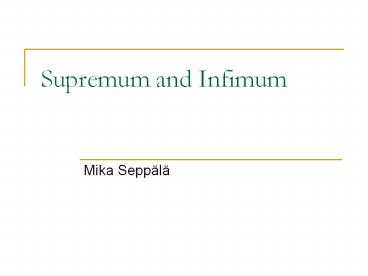Supremum and Infimum - PowerPoint PPT Presentation
1 / 12
Title:
Supremum and Infimum
Description:
Title: PowerPoint Presentation Last modified by: Mika Sepp l Created Date: 1/1/1601 12:00:00 AM Document presentation format: On-screen Show Other titles – PowerPoint PPT presentation
Number of Views:251
Avg rating:3.0/5.0
Title: Supremum and Infimum
1
Supremum and Infimum
- Mika Seppälä
2
Distance in the Set of Real Numbers
Definition
Triangle Inequality
Triangle inequality for the absolute value is
almost obvious. We have equality on the right
hand side if x and y are either both positive
or both negative (or one of them is 0).
We have equality on the left hand side if the
signs of x and y are opposite (or if one of
them is 0).
Definition
The distance between two real numbers x and y
is x-y.
3
Properties of the Absolute Value
Example
Proof
Problem
When do we have equality in the above estimate?
4
Solving Absolute Value Equations
Example
Solution
Conclusion
The equation has two solutions x 2 and x
-3.
5
Solving Absolute Value Inequalities
Example
Solution
Conclusion
6
Upper and Lower Bounds
Let A be a non-empty set of real numbers.
Definition
A set A need not have neither upper nor lower
bounds.
The set A is bounded from above if A has a
finite upper bound.
The set A is bounded from below if A has a
finite lower bound.
The set A is bounded if it has finite upper and
lower bounds.
7
Supremum
Completeness of Real Numbers
The set A has finite upper bounds. An
important completeness property of the set of
real numbers is that the set A has a unique
smallest upper bound.
Definition
The smallest upper bound of the set A is called
the supremum of the set A.
sup(A) the supremum of the set A.
Notation
Example
8
Infimum
The set A has finite lower bounds. As in the
case of upper bounds, the set of real numbers is
complete in the sense that the set A has a
unique largest lower bound.
Definition
The largest lower bound of the set A is called
the infimum of the set A.
inf(A) the infimum of the set A.
Notation
Example
9
Characterization of the Supremum (1)
Theorem
Proof
10
Characterization of the Supremum (2)
Theorem
Proof Contd
11
Characterization of the Infimum
Theorem
The proof of this result is a repetition of the
argument the previous proof for the supremum.
12
Usage of the Characterizations
Example
Claim
Proof of the Claim
1
2
1
2
and































